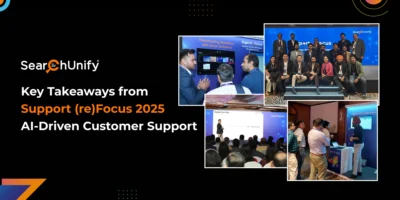
In the dynamic customer support landscape, maintaining exceptional customer satisfaction is paramount for business growth. Support teams face a constant flow of customer cases, and managing, prioritizing, and addressing critical issues can feel like juggling flaming chainsaws without any proactive support strategy.
This is where advanced “New vs. Known Case Analysis” kicks in, making the support team’s work more efficient and effective. It has emerged as a game changer for the customer support industry.
Imagine a scenario where a support agent solves a brand-new problem and proactively documents the solution in a knowledge article. It ensures that if a similar case rears its head again, the knowledge required for resolution is a mere click away.
But here’s the twist: whenever a similar issue is raised, how do you determine whether it is genuinely a new case or falls under the known issue category? Is it a triumph of proactiveness, or is it simply a case of inefficiency in knowledge management?
Fear not! In this blog post, we’ll delve into the intricacies of new vs. known case analysis, its significance and implementation, and how it can revolutionize your support operations.
Understanding New vs. Known
For support case management, distinguishing between “Known” and “New” cases is crucial for efficiency and customer satisfaction.


Proactive customer Support Excellence with New vs. Known Analysis

Recognition of New Support Cases
This report identifies the new cases whose resolutions have not been documented yet. It opens a lucrative opportunity to create new knowledge to address these cases and turn new issues into known ones.
Customers can self-serve for queries or issues they’re facing. And for those who still need assistance, support agents can address their concerns by linking relevant articles to the case.
Predictive Analytics and Trends
By analyzing the nature and frequency of new cases, you can foresee emerging trends and potential issues that can frustrate customers. Based on this report, the support team can formulate proactive strategies to address the critical issues before they become prevalent.
This approach not only reduces the volume of support cases but also keeps the customer experience soaring.
Self-service Optimization
Once known issues are identified, it is crucial to make the knowledge base available through a self-service support portal. This will increase the external reuse of your knowledge vault.
The best part? Customers resolve known issues independently, reducing the need to contact customer support. Therefore, it lessens the internal reuse of the knowledge base as support agents receive fewer recurring customer issues.
It’s a win-win for both! Robust knowledge management enhances customer satisfaction by providing instant access to solutions, and support agents can prioritize complex issues.
Knowledge Base Gaps Identification
This extensive analysis helps to understand why recurring issues are not resolved through self-service. It exposes knowledge base gaps, searchability issues, or the need for customer awareness of the self-service option.
With these insights, you can plug the leaks and ensure seamless customer support.
Product Development Enhancement
The insights gained from this analysis do not just reveal whether knowledge creation is required to resolve customer queries. Sometimes, they indicate that your products or services might need improvement.
Here’s where the magic happens: the support and product teams can collaborate to prioritize product enhancements that will leave customer issues in the dust.
Strategies to Reduce Known Issues in Incoming Support Cases
By analyzing insights, you can uncover areas for improvement and reduce the workload on the support team.

Knowledge Creation and Sharing: Boosting Support Performance
The analysis report identifies whether the existing knowledge base addresses the recurring issues. If not, there might be a knowledge gap. The support team identifies the gaps and creates knowledge articles to address them.
Sometimes, knowledge is present, but it is either outdated or misleading. Outdated knowledge feels like a maze, which doesn’t help customers resolve their concerns but makes them feel lost. Therefore, the support team should update and revise the knowledge articles to ensure effectiveness.
Adequate Linking Practice: Connecting Customers to Solutions
Consistent linking practice can be ensured through training and clear guidance for support agents. Linking the accurate resolution article to the support ticket while resolving customer queries reduces the recurrence of known issues.
Streamline the Self-Service Experience: Unleashing the Power of Knowledge
The more knowledge readily available to the customer, the more independently they can resolve their issues. It’s possible when customers use a self-service portal and easily access the required knowledge.
That’s where GenAI-powered search solutions come in, elevating search capabilities to the next level with vector search.
Imagine your search solution understanding the meaning and context of customers’ search queries and delivering more relevant and accurate results. That sounds cool, right?
Turbocharged Resolutions: Eliminating Information Roadblocks
A lack of information about the product or an inefficient knowledge base makes it challenging to resolve known issues. Addressing these informational gaps can streamline the resolution process, making it quicker and more efficient.
Implementing New vs. Known Case Analysis
So, are you planning to conduct a new vs. known case analysis? If yes, manual review is like an uphill battle. It takes time and effort and entirely relies on SMEs in the knowledge domain. They manually classify the cases as “new” and “known” by analyzing their knowledge base.
These standard practices involve various key steps to perform new vs. known analysis. The first step is defining the scope of the analysis and collecting relevant data, including the closed cases, within 90 days.
The next step is incident analysis by SMEs. They review and categorize incidents and associated knowledge articles.
This step is like moving mountains because SMEs require a pilot session to encourage discussion and apparent confusion, and gathering them in one place is challenging. Subsequent analyses can then be coordinated remotely.
The final step involves identifying and discussing opportunities for improvement based on the data collected. This step is not just about improving processes but also about enhancing the efficiency of handling known issues and improving the overall problem-solving process for new issues.
This step directly impacts the organization’s knowledge base, ensuring it is effectively utilized and continuously improved.
Sounds too much, right?
But what if you could turn the tables on this situation and get an automated new vs. known analysis? Well, it’s feasible with GenAI-powered knowledge management software like Knowbler.
By leveraging Knowbler, you can get an automated report that helps identify trends, patterns, and recurring problems, as well as which preventive measures are required.
Knowbler is powered by machine learning, ensuring it keeps you up-to-date. Now, you don’t have to wait three months to understand trends, as the report will be updated weekly with new classification trends.

Furthermore, access to fresh insights helps uncover opportunities to optimize support processes through knowledge management and empowers you to make data-driven decisions faster.
Additionally, this report classifies cases (new/known), establishes clusters for similar cases, and analyzes case volume by source. It is not over yet.
This report identifies potential shortcomings by analyzing various aspects, such as agents’ article-linking practices, knowledge gaps, or a high volume of support cases from particular channels.
Imagine a support agent failing to link the relevant knowledge article to a support case. What does it suggest?
- Either a knowledge article doesn’t exist
- If it’s there, the search functionality is not up to par.
- Agents require training and guidance to link relevant knowledge articles.
However, clusters with a high volume of new cases might indicate missing or incomplete information in your knowledge base.
Explore the Possibilities of New vs. Known Analysis with Knowbler
Knowbler offers a range of features, including automated summary and title generation, duplicate flags, new vs. known issue classification, and content health checks. With these tools at your disposal, you can supercharge your support operations and ensure that proactive support becomes not just a possibility but a reality.
Want to dig in about Knowbler and its “New vs. Known Analysis” feature? Check this out!
Also, if you are ready to embrace the era of proactive support, try Knowbler today and revolutionize how you manage support cases and knowledge articles!











